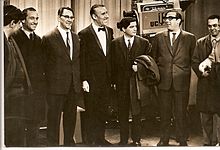Edmundo Rivero
Leonel Edmundo Rivero (born June 8, 1911 in Valentín Alsina , † January 18, 1986 in Buenos Aires ) was an Argentine tango singer and impresario.
Life
Edmundo Rivero was born in Valentín Alsina, a suburb of Buenos Aires. As a companion of his father on some trips, he got to know the lifestyle and the music of the gauchos of the province of Buenos Aires at an early age.
As a teenager, Rivero moves with his family to Belgrano , a district in the north of Buenos Aires. There he witnessed the growing popularity of the tango dance and the increasingly complex compositions, mainly by the composers Arolas, Bardi and Cobián known as "ABC". At the same time, the lyrics are changing from lighthearted teasing to more complex stories about love and male honor.
Rivero learns to play classical guitar and to sing. He has a deep bass-baritone voice that will become his trademark. He was also known for his huge hands (due to acromegaly ).
First he appeared as a singer in smaller halls, his first radio appearance was on Radio Cultura in a duet with his sister Eva. In the 1930s radio appearances alternated with appearances in dance halls.
In 1935 he was discovered by the band leader José de Caro, and soon afterwards he noticed José's more famous brother Julio de Caro , who poached him. Its orchestra, which also includes non-traditional instruments, was the main orchestra of the dance hall in the Pueyrredón Theater in Flores . During this time Rivero became better known and also got his nickname "El Feo" (The Ugly One).
Although Rivero appeared in many Argentine films of the 1930s and 1940s, the early 40s were an uncertain time for him as many band leaders (including Humberto Canaro ) wanted to work with him, but these collaborations were short-lived. Rivero later stated that his deep voice was a handicap at the time.
In 1944 Rivero teamed up with Horacio Salgán . In the three years of collaboration, no recordings were made because Salgán's music, which was influenced by Béla Bartók , did not meet the taste of ordinary tango listeners. However, Rivero gained reputation with avant-garde and jazz musicians. In order to be able to pay the rent, Rivero also recorded duets with Carlos Bermúdez, more commercial tango music for the Colombian market.
In 1947 Rivero was hired by Aníbal Troilo . Troilo was very successful with new songs, some of which were written in cooperation with the lyricist Homero Manzi . In the three years with Troilo, Rivero stood next to Floreal Ruiz and Aldo Calderón in the spotlight and recorded 22 songs, including the mega hit Sur .
Finally becoming famous and rich, Rivero left Toilo in 1950 and started a solo career. His accompaniment alternated between guitar quartets and orchestras. The most famous musician Rivero worked with was guitarist Roberto Grela , who also worked with Troilo.
Guitar ensembles were used as accompaniment by provincial milonga performers, tango singers from an earlier era, and even the young Carlos Gardel , but Rivero's choice was very unusual in the 1950s, when large orchestras dominated the music scene. This cemented his identification with the quiet masculinity of the rural people as a contrast to the emphasis on lost love in "urban" tango songs.
In the 1960s, Salgán and Rivero found satisfaction for their lack of commercial success in the late 1940s and recorded numerous records together. Rivero also worked with other artists who recognized his generosity and dedication to music. In 1966 he appeared in the film "Buenos Aires, verano 1912".
In the late 1960s, tango was primarily an "export product" as both the musicians and their audiences were aging and fixated on old songs and orchestral formats from the 1940s and 1950s. Many tango fans also rejected the music of Astor Piazzolla and his followers. Rivero himself admired Piazzolla and recorded several compositions by him. In those years even well-known artists struggled to find places to perform.
Concerned that the tango might not survive, Rivero opened “El viejo Almacén” (The Old Shop) in the San Telmo district in 1969 . His hospitality delighted many visitors to the city who went to Rivero's Club to enjoy tango music and dance. Among the more frequent visitors were Joan Manuel Serrat and Camilo José Cela .
Rivero was an icon in Japan , where he toured in 1968. There he met many Japanese musicians and dancers and wrote tangos such as “Arigato Japón” (thank you, Japan) and “A lo Megata” (Tsunayoshi Megata was a well-known Japanese tango dancer). No Japanese tourist would have left Buenos Aires without visiting the Almacén at least once.
In the early 1970s, Rivero hosted a television show featuring artists from his club, including Beba Bidart . It also aired some of his reunions with Troilo and Grela from the 1960s and 1970s.
In 1980 Rivero took part in the concert on the occasion of Osvaldo Pugliese's 75th birthday. In late 1985, Rivero was admitted to the hospital. He died on January 18, 1986 after a heart attack.
Discography (selection)
- Sur (probably the most popular Argentine tango)
- El ciruja
- Amablemente (a sonnet sung as a milonga )
- Pucherito de gallina
- No te engañes corazón
- Malón de ausencia
- Yo te bendigo
- Falsia
- El último organito
Web links
| personal data | |
|---|---|
| SURNAME | Rivero, Edmundo |
| ALTERNATIVE NAMES | Rivero, Leonel Edmundo (full name) |
| BRIEF DESCRIPTION | Argentine tango singer |
| DATE OF BIRTH | June 8, 1911 |
| PLACE OF BIRTH | Valentín Alsina , Argentina |
| DATE OF DEATH | January 18, 1986 |
| Place of death | Buenos Aires , Argentina |

